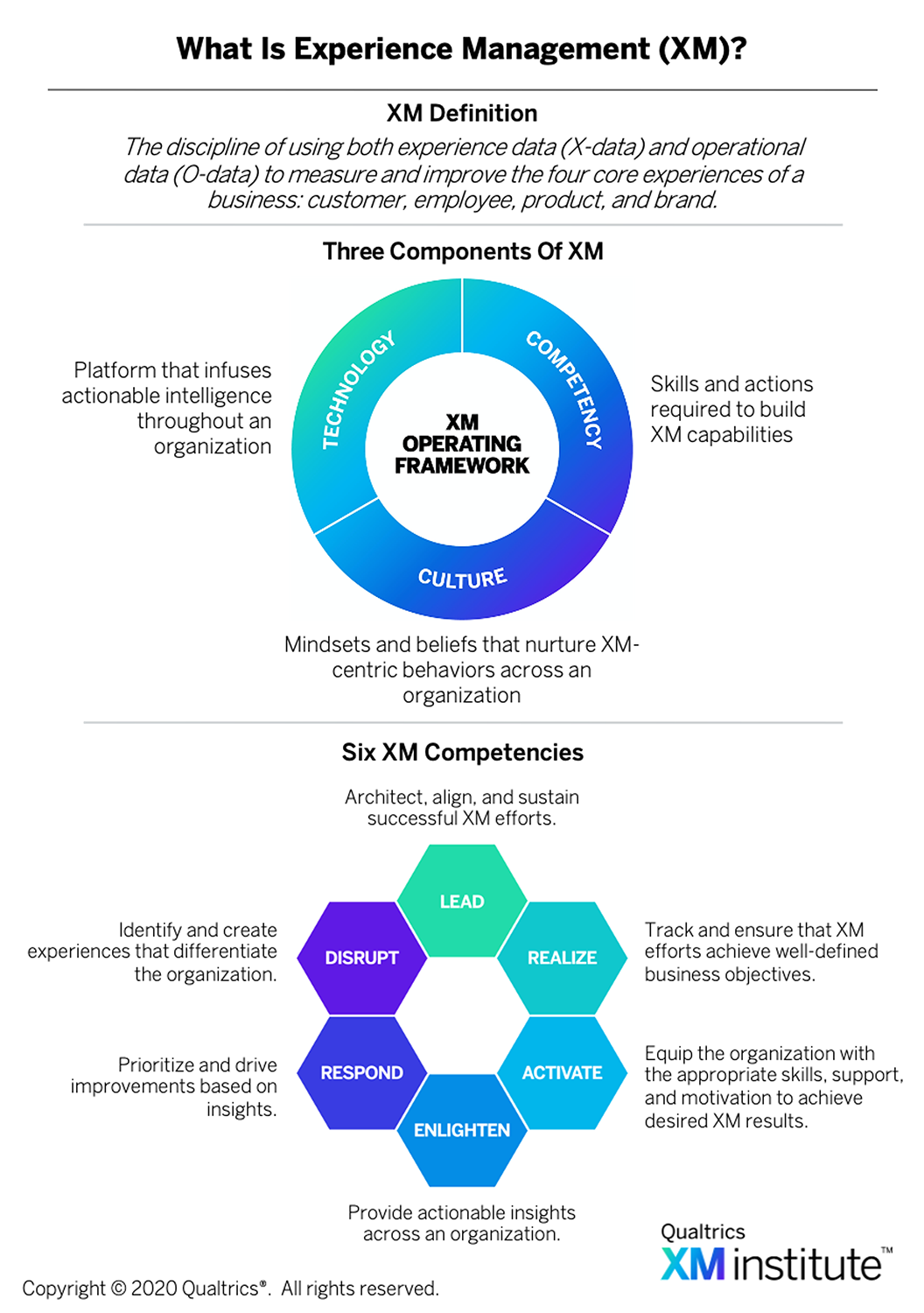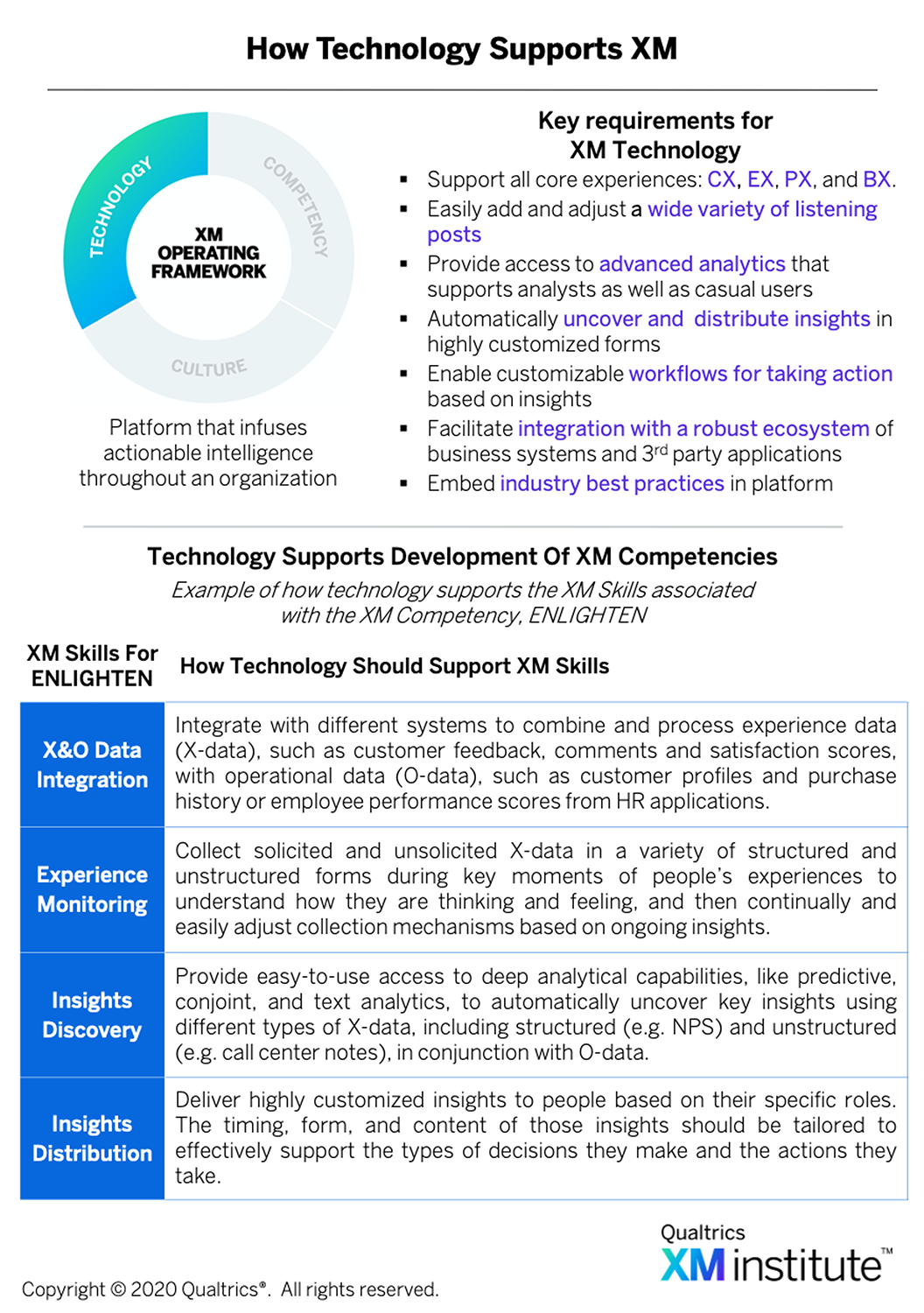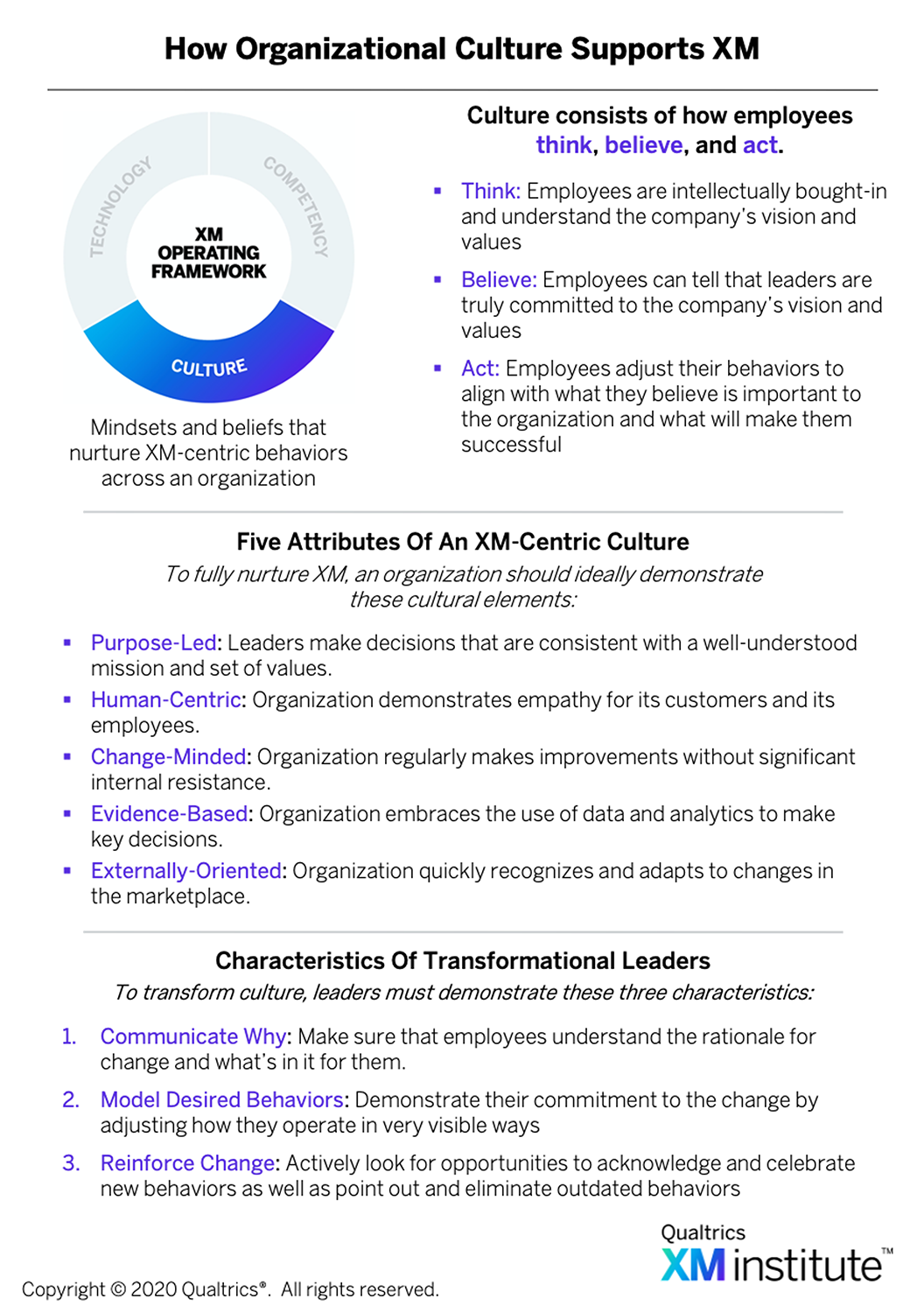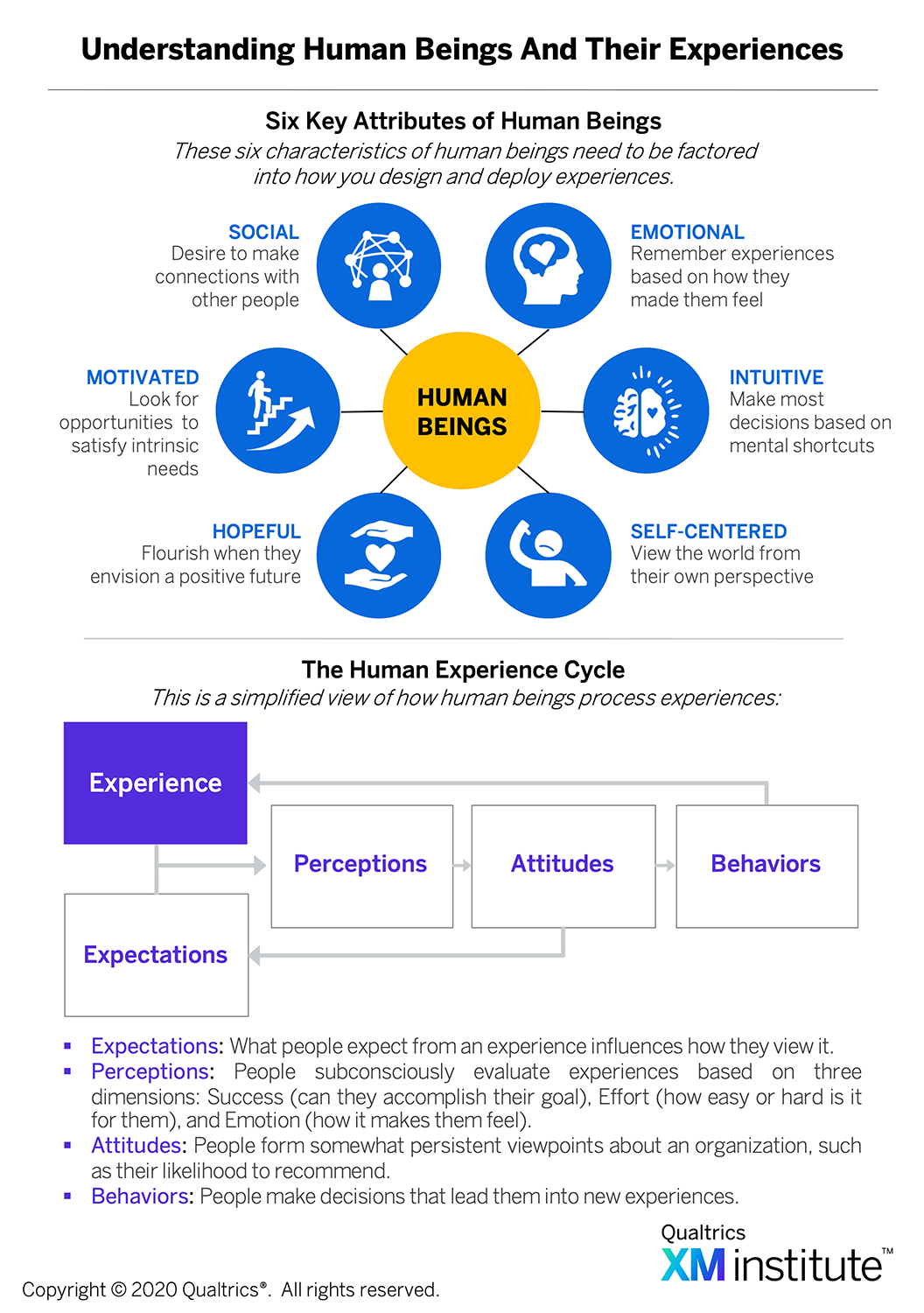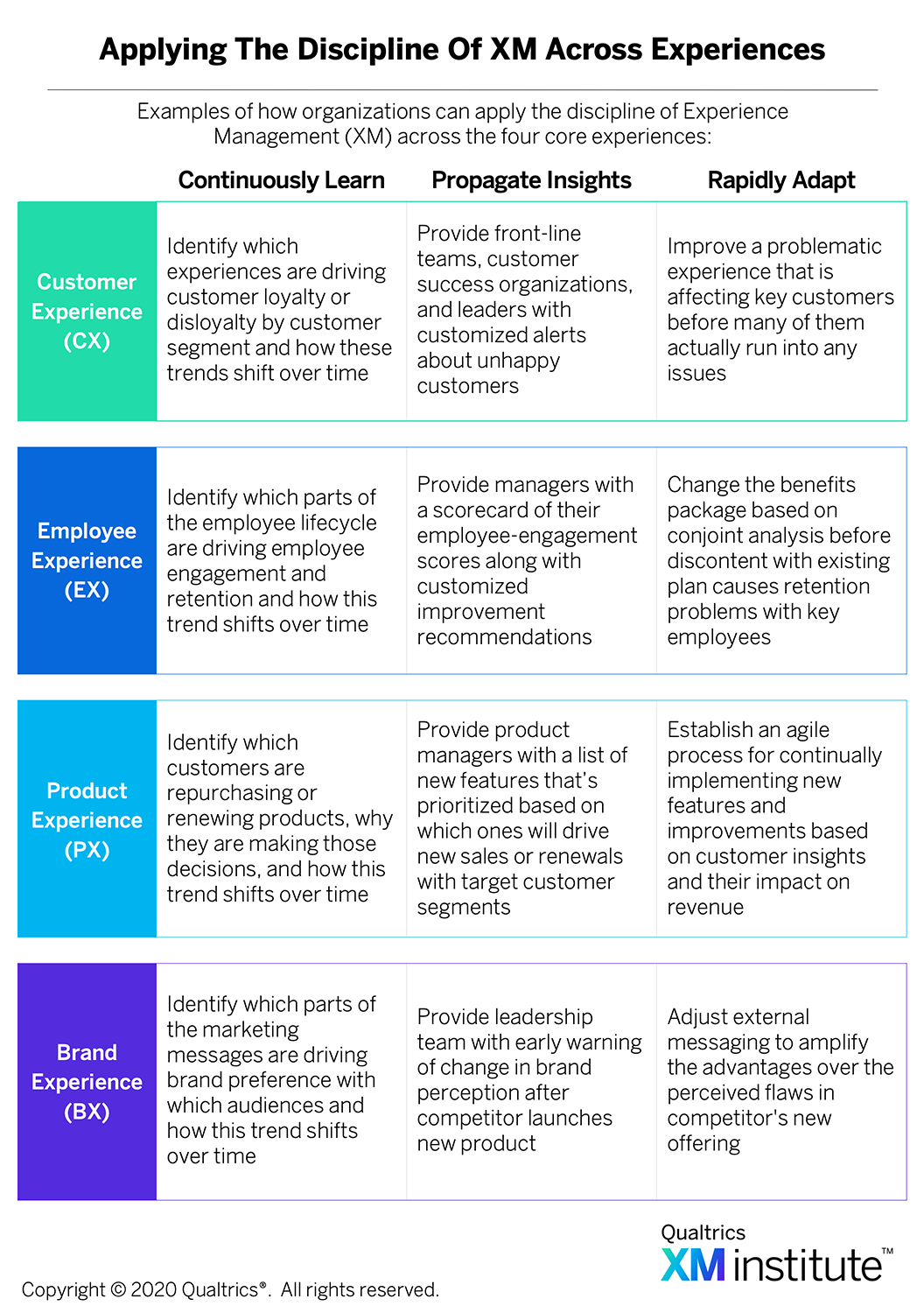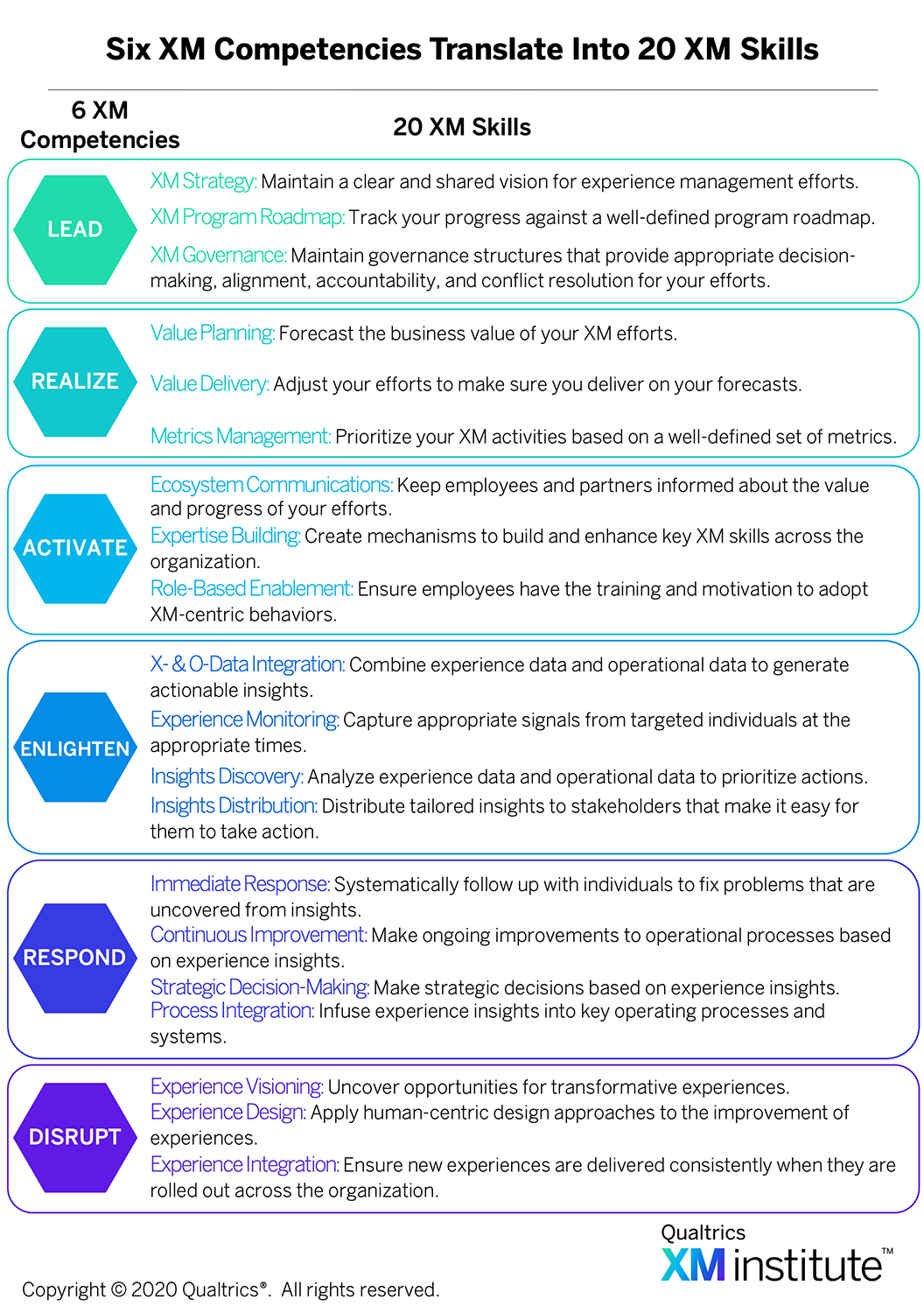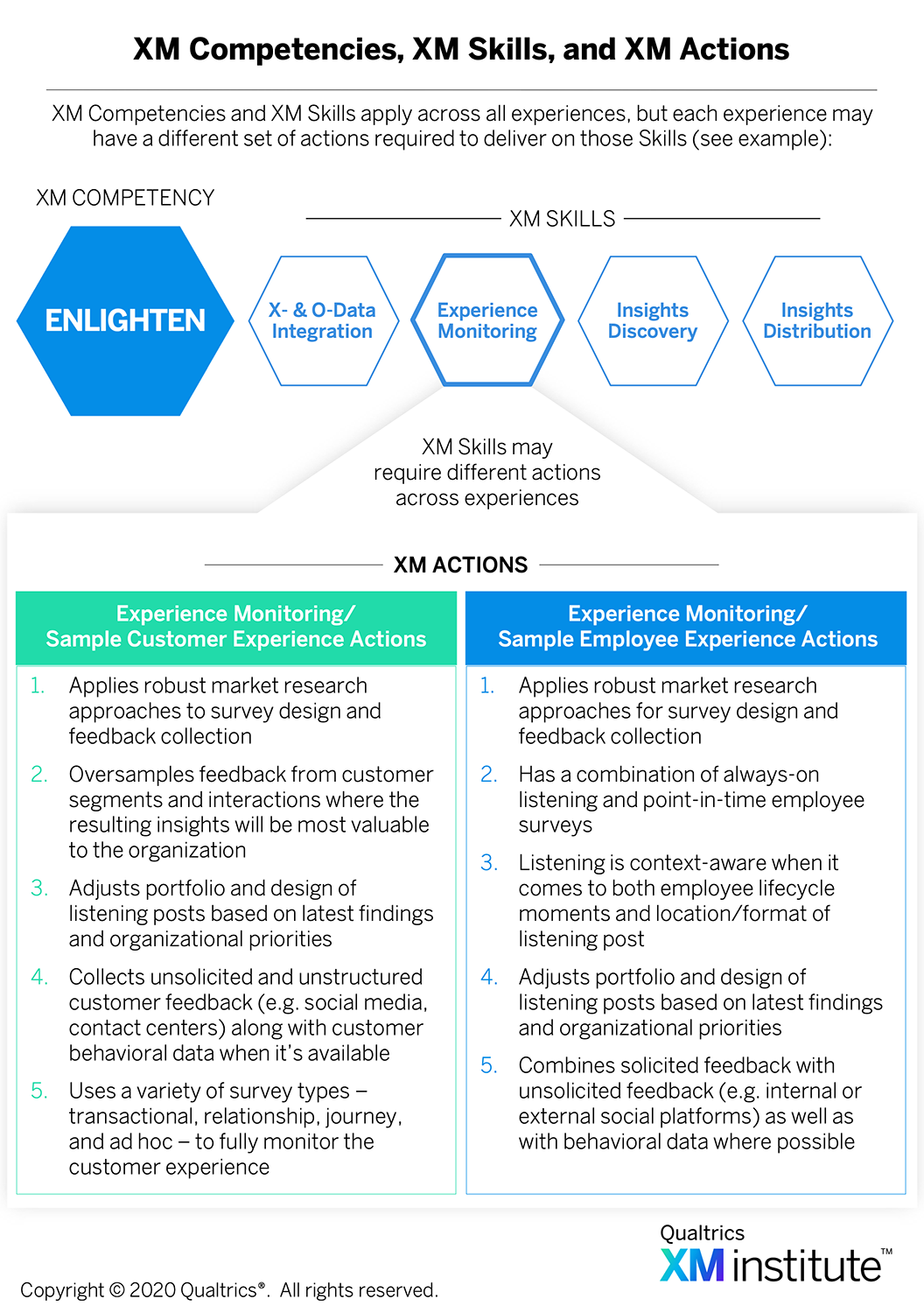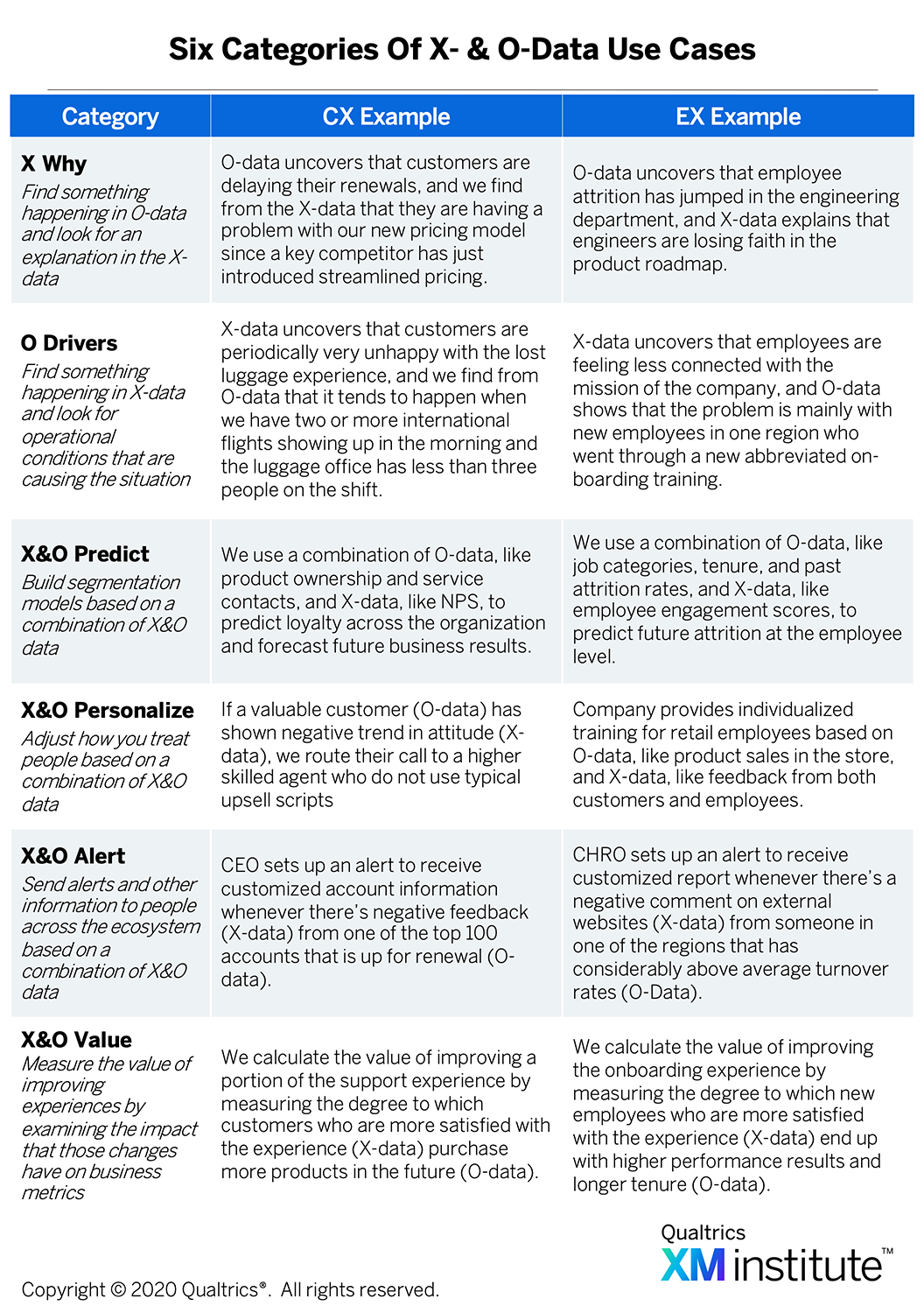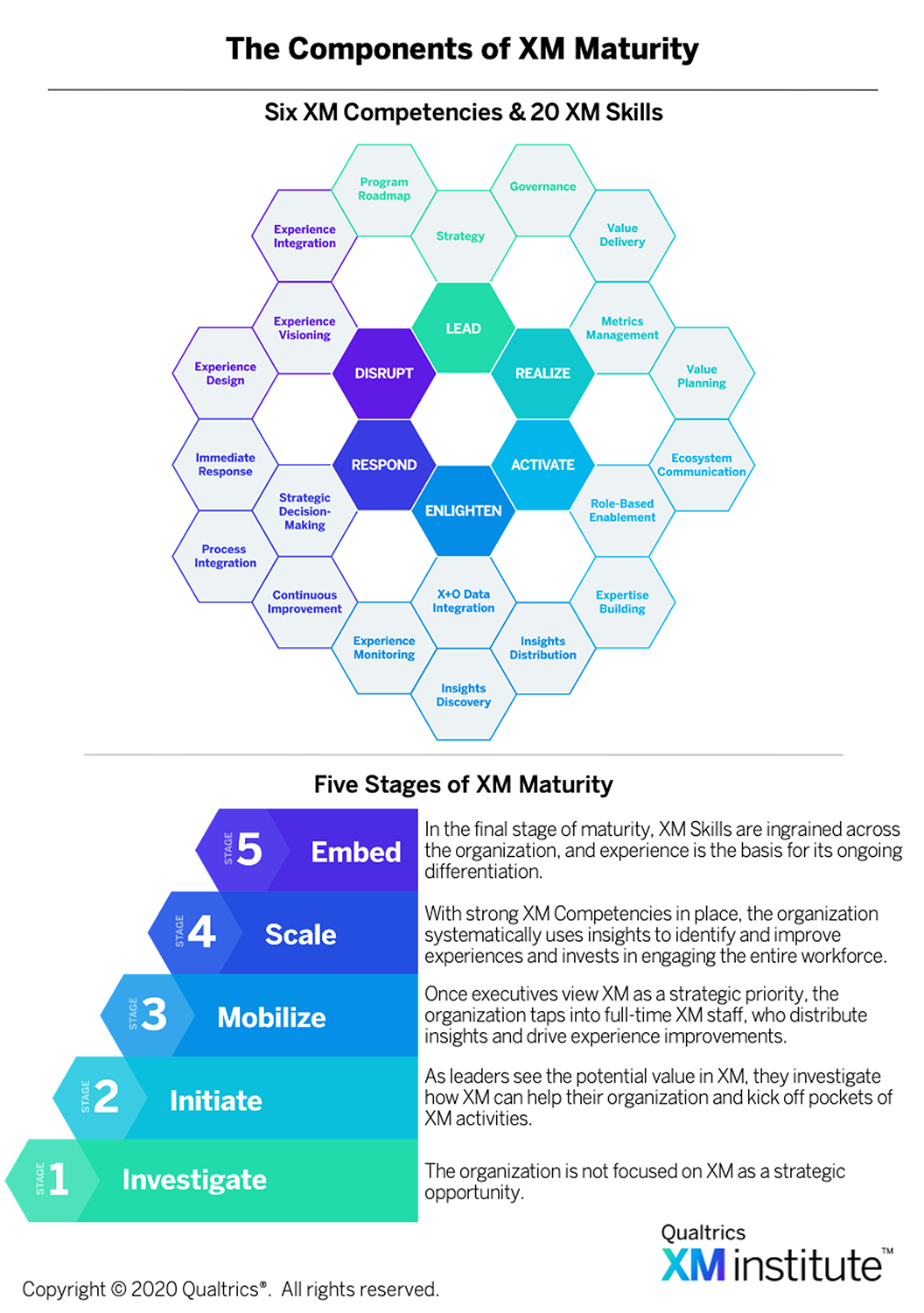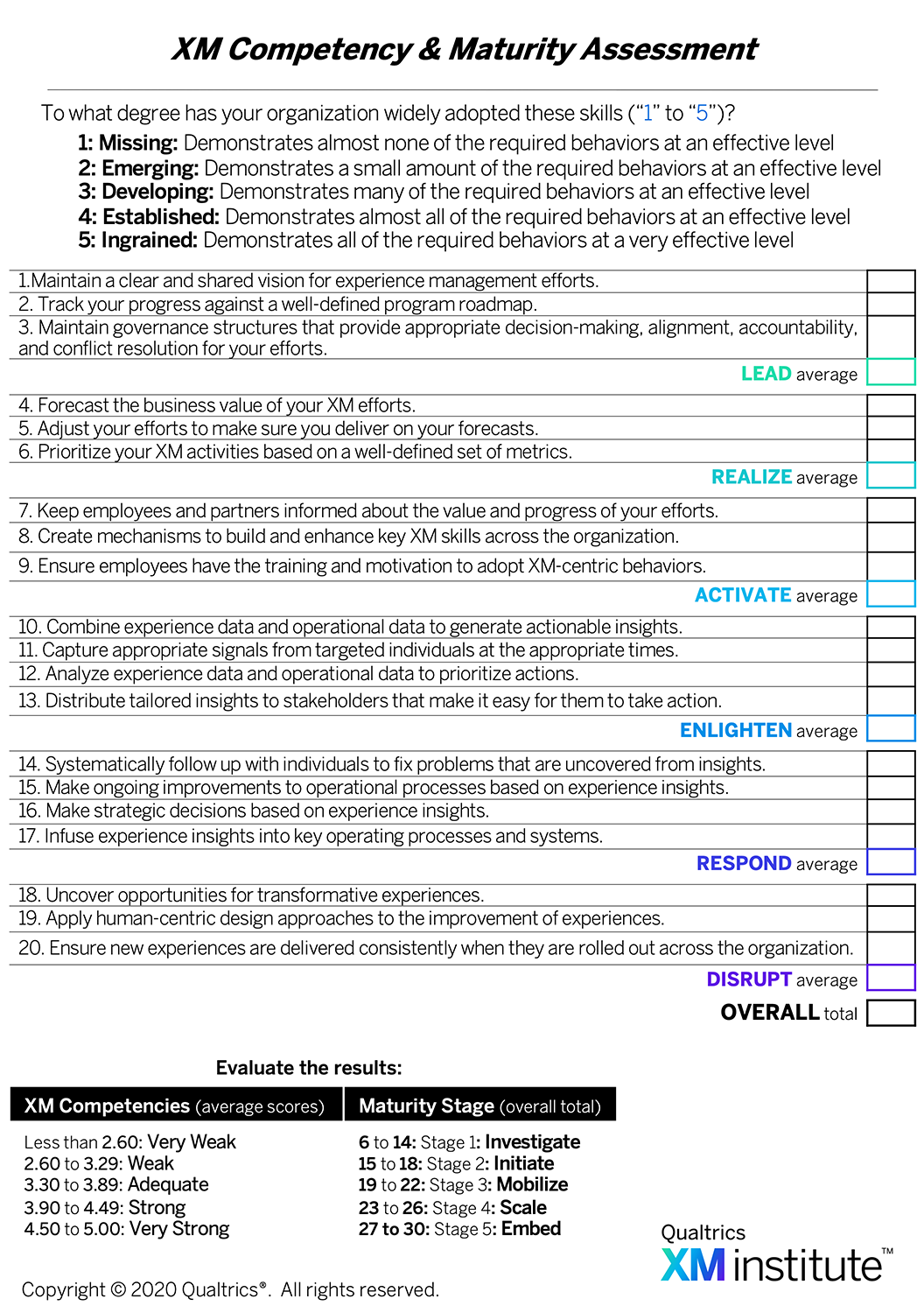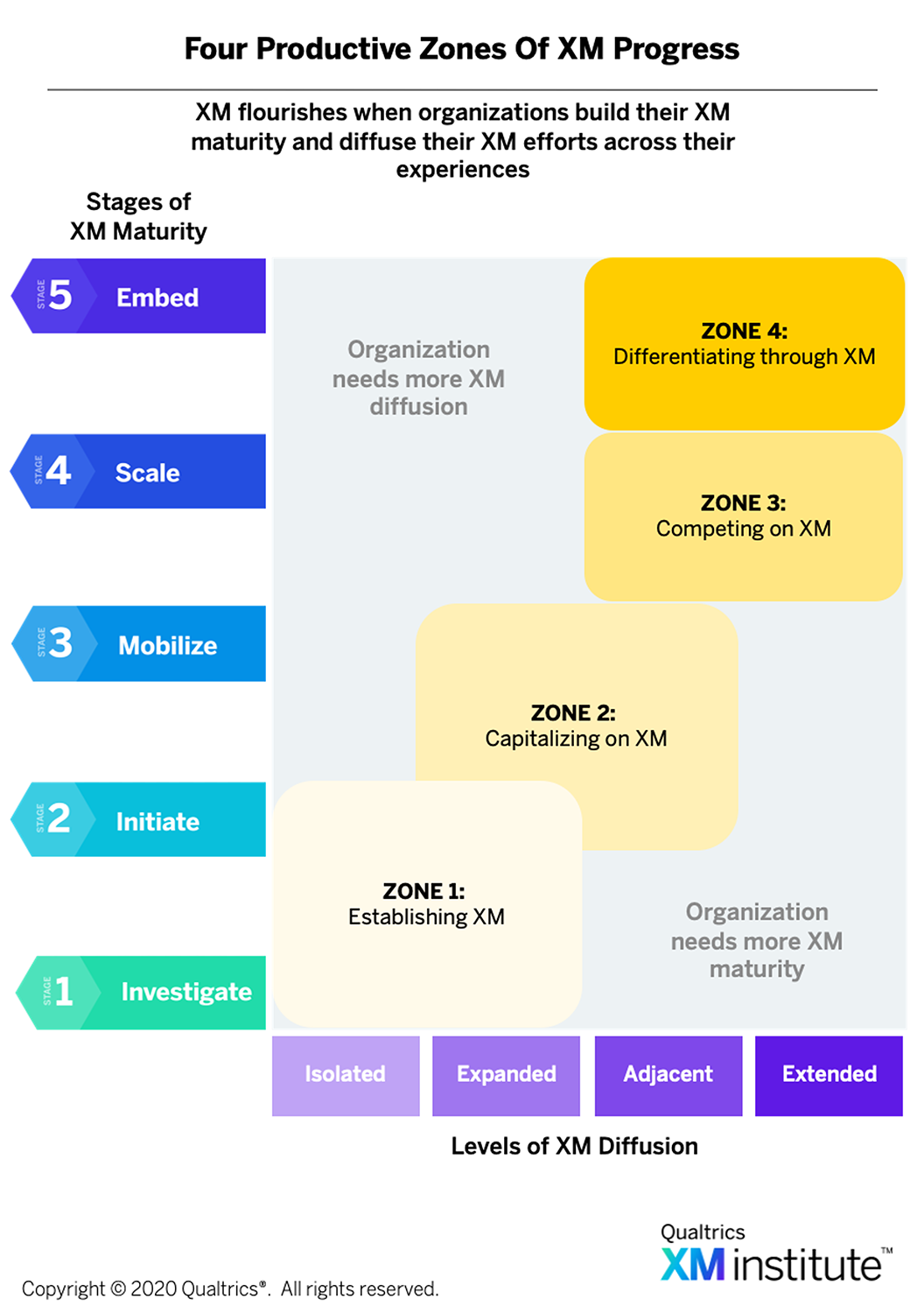Experience Management: Combining Intelligence & Humanity
The environment in which organizations operate is changing. The ever-increasing flow of information is shifting power from institutions to individuals. At the same time, new technologies are redefining business models and shortening product lifecycles. To compete in this fast-changing environment, organizations need to build a new set of capabilities, one that allows them to rapidly deliver on what people really care about – their experiences. We call this approach Experience Management (XM) and define it as (see Figure 1):
The discipline of using both experience data (X-data) and operational data (O-data) to measure and improve the four core experiences of business: customer, employee, product and brand.
How can you enable this discipline within your organization? By focusing on three areas:
- Competency. To gain value from XM, organizations need to alter how they operate, developing new approaches for using insights. This will allow them to deliver highly targeted experiences to the right audiences. Competencies are the skills and actions that ultimately establish XM as a discipline. We’ve identified six XM Competencies: LEAD, REALIZE, ACTIVATE, RESPOND, ENLIGHTEN, and DISRUPT.
- Technology. To consistently master the competencies at scale, organizations need a platform that is capable of collecting, analyzing, and distributing insights to the relevant people and processes (see Figure 2). This technology empowers everyone to understand and – more importantly – take action on the insights generated from both X-data and O-data.
- Culture. For XM competencies to thrive, companies need to foster an environment that instills XM-centric mindsets and behaviors in their leaders and employees (see Figure 3). The culture of an organization can either accelerate or inhibit the spread of XM competencies. A company’s culture, therefore, is ultimately what is going to allow XM efforts to gain momentum and ensure that XM practices are happening consistently across the organization, rather than just in isolated pockets.
XM Will Redefine the Delivery of All Experiences
Historically, organizations treated human beings—from suppliers to employees to partners to customers—like robots who move mindlessly and emotionlessly from one interaction to the next. In this new environment, however, companies can no longer afford to overlook people’s needs and motivations (see Figure 4).
As organizations master XM, they will establish capabilities to continuously learn what people are thinking and feeling, propagate insights across their ecosystem, and rapidly adapt based on the most important findings. These new competencies will enable companies to dramatically improve the four core experiences (see Figure 5):
- Customer Experience. Companies will be able to thoughtfully tailor experiences for different customer segments and will rapidly identify and respond to any problems or opportunities with individual customers or segments. An airline’s X-data may show a periodic steep decline in customers’ satisfaction with the lost luggage experience, and their O-data may reveal that this drop tends to happen when two or more international flights arrive within 20 minutes of each other. The airline could act on this information by dynamically adjusting its staffing model based on flight schedules. A B2B manufacturer’s O-data may show that its customers are delaying their renewals, triggering it to collect X-data, which reveals that a key competitor is more aggressively discounting products with a specific set of customers.
- Employee Experience. Companies will know how employees feel about the company throughout their entire employment lifecycle – from application to resignation. If a company’s X-data uncovers that its employees are feeling less connected to the mission of the company, it could then use O-data to discover that the problem lies mainly with recent hires from a single region who went through a new, abbreviated on-boarding training. And when the company needs to make decisions about compensation and benefit options, it can tap into X- and O-data to identify which combinations will resonate most strongly with different groups of employees.
- Brand Experience. Companies will understand how different segments of customers and prospects view their brand and will quickly recognize if there’s a meaningful change in that perception. Following several highly publicized data breaches in its industry, a financial services company may collect X-data to monitor how people view the relative importance of data security updates, and it may view that information alongside O-data – such as demographic information and account type – to ensure that its marketing communications are effectively addressing the topics that are most important to target segments.
- Product Experience. Companies will understand which features are most valued by different customers and will swiftly determine if any product issues are serious enough to cause significant sales or renewal problems. An electronics manufacturer’s O-data may reveal a lag in the purchase and adoption of a specific accessory component to one of its primary pieces of equipment, and X-data may reveal that both internal teams, like sales and support, and customers are unclear about the accessory’s benefits or its value proposition. This understanding could lead the company to develop new internal training programs and external marketing campaigns.
Six XM Competencies and Twenty XM Skills
XM is not a set of activities that companies can simply add on to their existing to-do list. It is a discipline, which means that to achieve the most value from their efforts, organizations must incorporate XM into every facet of their business. How exactly should a company go about developing its XM capabilities? By building six XM Competencies and 20 XM Skills (see Figure 6), (see Figure 7):
- Lead. This competency is about articulating a clear XM strategy and then coordinating the execution of that strategy across many different people and projects over multiple years. This competency is about architecting, aligning, and sustaining successful XM efforts.
- Realize. For XM efforts to have a lasting positive impact, they must align with the overall priorities of the organization. Realize is about ensuring that XM efforts use the right metrics and achieve well-defined business objectives.
- Activate. People generally gravitate towards the status quo, so XM efforts must help overcome this natural inertia. This competency is about making sure that people at the organization – including employees, leaders, and partners – have the appropriate skills, support, and motivation to achieve desired XM results.
- Enlighten. To improve the experiences it delivers, an organization must be capable of collecting and processing a constant flow of X-data and O-data and then transforming it into useful information. This competency is about collecting and analyzing data in order to provide actionable insights across and organization.
- Respond. Sharing insights is not enough. This competency is about building organizational mechanisms to continuously take action on the insights being distributed.
- Disrupt. While finding and fixing problems is necessary, it alone is not sufficient for capturing people’s hearts and minds. Disrupt is about identifying and designing experiences that differentiate the organization from competitors.
XM Competency: LEAD
The LEAD Competency is about architecting, aligning, and sustaining successful XM efforts. We’ve defined three XM Skills under this Competency:
- XM Strategy: To keep their XM activities all aligned, organizations must develop, share, and maintain a clear vision for their XM efforts. A strong program follows a well-defined XM strategy that ties to business and brand objectives.
- XM Roadmap: As XM success requires companies to coordinate across a number of different teams and projects over a long period of time, firms must develop and track their progress against a plan with well-defined streams of effort. This roadmap should identify which experiences, segments, journeys, products, and services the organization considers the key areas of focus and plans to tackle first.
- XM Governance: Since XM affects almost the entire organization, it requires companies to coordinate their efforts across a number of different teams, projects, and departments. To manage all these activities, companies need to establish and maintain organizational governance structures that provide the appropriate decision-making, alignment, accountability, and conflict resolution. A strong governance structure will, for example, have a member of top management as an executive sponsor who’s responsible for supporting and advocating for the XM program among his or her peers.
XM Competency: REALIZE
The REALIZE Competency is about ensuring that XM efforts use the right metrics and achieve well-defined business objectives. We’ve defined three XM Skills under this Competency:
- Value Planning. Organizations should start their XM journeys with a clear definition of what they want their efforts to achieve. This involves forecasting the specific business value of XM efforts and defining how exactly this value will be tracked. One way companies can predict expected value is by creating a model that shows how changes in key XM metrics, like NPS, employee engagement, or brand perception, will deliver desired business results, like improving customer retention, lowering staff turnover, or reducing cost to serve.
- Value Delivery. The context in which organizations deliver experiences is constantly changing – people’s expectations change, competitors change, business strategy changes – which means companies need to continuously track the value they are creating and make ongoing adjustments to the experiences. One of the keys to successful Value Delivery is instituting a regular cadence of examining, and potentially resetting, business goals.
- Metrics Management. A strong XM program identifies key metrics using X- and O-data and then uses those metrics to drive operational priorities. The metrics program must define realistic targets for its core XM metric as well as all its key driver metrics based on how they influence desired business outcomes.
XM Competency: ACTIVATE
The ACTIVATE Competency is about making sure that people at the organization – including employees, leaders, and partners – have the appropriate skills, support, and motivation to achieve desired XM results. We’ve defined three XM Skills under this Competency:
- Ecosystem Communications. People are more likely to stay aligned with transformation efforts when they understand why things are changing, so XM programs must keep employees and partners informed about the value and progress of their efforts. To be effective, communications should define key messages and cascade them through management layers and across teams, reaching all levels of the organization.
- Expertise Building. Since XM requires people to learn a new set of behaviors and practices, organizations will need to build, proliferate, and enhance key XM skills. One way that companies can build expertise is by using Centers of Excellence, a set of people who develop and maintain mastery of critical skills, to enhance key XM capabilities and share best practices across the organization.
- Role-Based Enablement. Companies must ensure that their employees and partners have the skills, training, tools, and motivation to successfully adopt XM-centric behaviors. Since positive reinforcement is key to changing behaviors, organizations should recognize and celebrate the individuals and teams who demonstrate desired XM practices.
XM Competency: ENLIGHTEN
The ENLIGHTEN Competency is about collecting and analyzing data in order to provide actionable insights across and organization. We’ve defined four XM Skills under this Competency:
- X- and O-Data Integration. Companies can generate actionable insights by combining O-data – such as segment profiles, product ownership, work history, and previous interactions – together with X-data in a single system (see Figure 8). Bringing these disparate data sources together will facilitate the use of advanced analytics and ultimately yield richer insights.
- Experience Monitoring. XM programs must identify and capture the appropriate signals from the appropriate audiences at the appropriate times. One activity that’s crucial to mastering this skill is oversampling feedback from key customer and employee segments during interactions where the resulting insights will be most valuable to the organization.
- Insights Discovery. XM efforts must constantly analyze X- and O-data to uncover meaningful insights and identify which actions to prioritize. Companies can generate deeper, richer insights when they analyze the data by customer and employee segments and when they blend together quantitative and qualitative feedback.
- Insights Distribution. XM truly becomes valuable when companies share X- and O-data insights in the right form, at the right time, and tailored to the people best equipped to act on the information. This skill includes creating customized alerts and dashboards that are synchronized to the operational and decision-making cadences of internal stakeholders.
XM Competency: RESPOND
The RESPOND Competency is about building organizational mechanisms to continuously take action on the insights being distributed. We’ve defined four XM Skills under this Competency:
- Immediate Response. Any successful XM effort must include the capability to systematically follow up with people who are affected by an experience – as indicated by their feedback or discovered through analytics – and fix the problems that are uncovered. To master this skill, companies should automate and manage a closed-loop process using tools such as ticket management, status updating, and tracking.
- Continuous Improvement. Organizations need to make ongoing changes to operational processes based on a continuous flow of X- and O-data insights. This skill often includes a well-defined process for diagnosing and prioritizing potential areas of improvement depending on how they would impact experiences and business results.
- Strategic Decision-Making. Organizations should use insights from X- and O-data to make strategic decisions. A good starting point for this skill is to develop XM goals and targets for the executive team and then thoughtfully cascade those objectives throughout the rest of the organization.
- Process Integration. In addition to making decisions based on insights, organizations should infuse those insights into key operating processes and systems. For instance, organizations should use employee feedback to tailor the curriculum and content of their leadership development program.
XM Competency: DISRUPT
The DISRUPT Competency is about identifying and designing experiences that differentiate the organization from competitors. We’ve defined three XM Skills under this Competency:
- Experience Visioning. The foundation of this skill is uncovering opportunities for disruptive new experiences. One of the ways companies can implement this capability is by creating journey maps, which will allow them to both understand customer needs and perceptions and uncover potential opportunities for improvement.
- Experience Design. Once companies have identified a potential opportunity, they need to apply human-centric approaches to create or improve that experience. To do this, organizations should consider involving customers and employees in the design process through co-creation sessions and ongoing testing.
- Experience Integration. It’s not enough to just design new experiences. Strong XM requires organizations to develop the processes, systems, and training that will enable them to deliver new experiences in a consistent fashion. For example, companies must keep resources assigned to new experience deployments until they can conclusively demonstrate that these experiences are creating the desired customer or employee perceptions.
Five Stages of XM Maturity
As organizations build out and master these six XM Competencies, they will evolve through five stages of maturity (see Figure 9):
- Stage 1: Investigate. The organization is not focused on XM as a strategic opportunity. Companies in this stage should work on identifying the “best” first steps and building buy-in with senior executives to acquire the resources needed for moving forward.
- Stage 2: Initiate. As leaders see the potential value in XM, they investigate how XM can help their organization and kick off isolated pockets of XM activities. Companies in this stage should work on building a broader understanding of and cross-functional support for the XM strategy. They should also focus on delivering value from their initial efforts so they can gain the next level of executive and organizational commitment.
- Stage 3: Mobilize. Once executives view XM as a strategic priority, the organization taps into full-time XM staff, who distribute insights and drive experience improvements. Companies in this stage should work on developing XM programs that drive action and improve pain points. They should also engage employees across the organization in understanding and demonstrating good XM behaviors.
- Stage 4: Scale. With strong XM Competencies in place, the organization systematically uses insights to identify and improve experiences and invests in engaging the entire workforce in XM. Companies in this stage should use advanced analytics and XM metrics to improve experiences targeted at narrower segments of people, and design new processes that span multiple lines of business. They should also reinforce good XM behaviors by deeply integrating XM into their HR processes.
- Stage 5: Embed. In the final stage of maturity, XM Skills are ingrained across the organization and it is able to rapidly adapt to shifts in the marketplace. Mature XM programs enable the organization to continuously listen, propagate insights, and rapidly adapt to the needs and expectations of customers, employees, partners, and suppliers.
Assessing Your XM Competency and Maturity
To help you gauge your organization’s progress on its XM journey, the Qualtrics XM Institute has created the XM Competency & Maturity Assessment (see Figure 10). You can use this tool in a number of different ways:
- Self-assessments. Take the test yourself and identify your organization’s strengths and weaknesses across each of the core experiences: CX, EX, PX, and BX. Just replace “XM” with the specific experience you want to evaluate. You can also use the evaluation for different departments or business units.
- Group discussions. Have multiple people complete the self-assessment and then review the results as a group. Discuss the strengths and weaknesses you’ve identified as well as which areas you all agree on and which you disagree on.
- Action planning. Develop plans for making progress towards mastering XM. You can do this in one core experience or across multiple experiences.
- Progress tracking. Repeat the self-test every six to 12 months to track your progress and identify your key areas of focus. The goal is to drive an ongoing discussion and continue prioritizing XM efforts.
The XM Diffusion Path
While it is no doubt essential that organizations increase their maturity across the XM Competencies, for XM to truly flourish inside a company, it must also apply the XM discipline to an increasingly broad array of experiences. This process, which we call “XM Diffusion,” will often spread across an organization in the following order:
- Step 1: Isolated Experiences. Organizations will start practicing XM in one use case or across a few tightly related use cases. For example, a company may kick off its XM efforts by taking action based on the results of a relationship NPS survey and a contact center post-transaction survey or by conducting an annual engagement study and a quarterly employee pulse survey.
- Step 2: Expanded Experiences. After building some XM maturity and seeing the value in the initial use cases, organizations will expand into other similar areas or enhance their existing capabilities. For instance, based on the results of its initial NPS and post-transaction surveys, a company may increase the number of its listening posts and add more advanced capabilities, such as text and predictive analytics.
- Step 3: Adjacent Experiences. Once there are several use cases underway, organizations will find that there are elements of other experiences that impact the success of those use cases, so they will incorporate those experiences into their XM program. After expanding XM across multiple CX use cases, for instance, companies often recognize that they need to incorporate EX activities into those efforts to achieve their CX goals. Or efforts might start with EX and then expand into BX after the company recognizes that brand perception is a critical obstacle to attracting new talent.
- Step 4: Extended Experiences. Once organizations have applied XM to the major experience areas (CX, EX, BX, and PX), they will look to apply XM to every new experience they are creating, whether it’s redesigning their parking lot or rolling out a new community fundraising event. They’ll also start to focus on experiences that are outside of their control but within their sphere of influence, such as the EX delivered by recruiting partners or the CX delivered by distributors.
Four Productive Zones of XM Progress
Companies’ XM efforts have the potential to falter if they over-invest in maturing only a few isolated experiences or if they spread their XM resources too thin across too many different experiences. Organizations should therefore focus on maturing and diffusing their XM efforts in tandem. When done correctly, companies will flow through four productive zones of XM progress (see Figure 11):
- Zone 1: Establishing XM. When an organization has a low level of XM maturity, it should focus on Isolated or Expanded experience use cases. In this zone, a company needs to focus on establishing a strong set of core XM Competencies upon which it can build.
- Zone 2: Capitalizing on XM. After it’s established a set of basic capabilities, the organization should widen the scope of its XM efforts to encompass Adjacent experiences while also building the skills necessary to reach the Mobilize stage of maturity. In this zone, a company will start to see significant value—such as increased customer loyalty, lower employee turnover, higher product retention rates, and improved brand perceptions—from their XM efforts.
- Zone 3: Competing on XM. Once an organization hits the Scale level of maturity across Adjacent experiences, the value created by its XM efforts will start to accelerate and delivering high-quality experiences will be a key piece of its value proposition. In this zone, nearly every aspect of a company’s operations is successful at continuously learning, propagating insights, and rapidly adapting.
- Zone 4: Differentiating through XM. When an organization reaches the highest level of XM maturity across most of its experiences, it will be capable of delivering highly tailored experiences to numerous different audiences. Additionally, because it is so efficient at incorporating insights into its processes, it will be able to make decisions too quickly for competitors to keep up.


